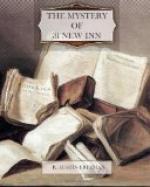Mr. Winwood grunted a grudging assent, and Thorndyke resumed:
“We have now furnished fairly conclusive evidence on three heads: we have proved that the sick man, Graves, was Jeffrey Blackmore; that the tenant of New Inn was John Blackmore; and that the man Weiss was also John Blackmore. We now have to prove that John and Jeffrey were together in the chambers at New Inn on the night of Jeffrey’s death.
“We know that two persons, and two persons only, came from Kennington Lane to New Inn. But one of those persons was the tenant of New Inn—that is, John Blackmore. Who was the other? Jeffrey is known by us to have been at Kennington Lane. His body was found on the following morning in the room at New Inn. No third person is known to have come from Kennington Lane; no third person is known to have arrived at New Inn. The inference, by exclusion, is that the second person—the woman—was Jeffrey.
“Again; Jeffrey had to be brought from Kennington to the inn by John. But John was personating Jeffrey and was made up to resemble him very closely. If Jeffrey were undisguised the two men would be almost exactly alike; which would be very noticeable in any case and suspicious after the death of one of them. Therefore Jeffrey would have to be disguised in some way; and what disguise could be simpler and more effective than the one that I suggest was used?
“Again; it was unavoidable that some one—the cabman—should know that Jeffrey was not alone when he came to the inn that night. If the fact had leaked out and it had become known that a man had accompanied him to his chambers, some suspicion might have arisen, and that suspicion would have pointed to John, who was directly interested in his brother’s death. But if it had transpired that Jeffrey was accompanied by a woman, there would have been less suspicion, and that suspicion would not have pointed to John Blackmore.
“Thus all the general probabilities are in favour of the hypothesis that this woman was Jeffrey Blackmore. There is, however, an item of positive evidence that strongly supports this view. When I examined the clothing of the deceased, I found on the trousers a horizontal crease on each leg as if the trousers had been turned up half-way to the knees. This appearance is quite understandable if we suppose that the trousers were worn under a skirt and were turned up so that they should not be accidentally seen. Otherwise it is quite incomprehensible.”
“Is it not rather strange,” said Marchmont, “that Jeffrey should have allowed himself to be dressed up in this remarkable manner?”
“I think not,” replied Thorndyke. “There is no reason to suppose that he knew how he was dressed. You have heard Jervis’s description of his condition; that of a mere automaton. You know that without his spectacles he was practically blind, and that he could not have worn them since we found them at the house in Kennington Lane. Probably his head was wrapped up in the veil, and the skirt and mantle put on afterwards; but, in any case, his condition rendered him practically devoid of will power. That is all the evidence I have to prove that the unknown woman was Jeffrey. It is not conclusive but it is convincing enough for our purpose, seeing that the case against John Blackmore does not depend upon it.”




